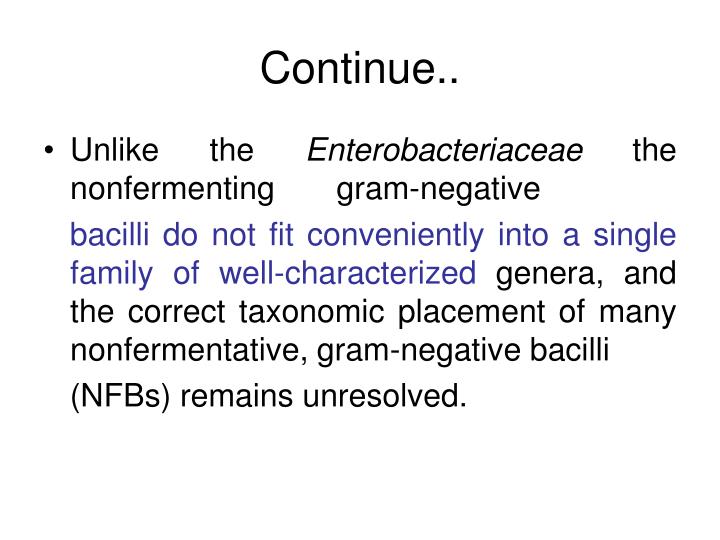

Available from: Īerobic non fermenting gram negative bacilli (NFGNB) are a taxonomically diverse group of organisms that either do not utilize glucose as a source of energy or utilize it oxidatively. Prevalence of non-fermenting gram negative bacilli and their in vitro susceptibility pattern in a tertiary care hospital of Uttarakhand: A study from foothills of Himalayas.
#NON LACTOSE FERMENTING GRAM NEGATIVE RODS TREATMENT HOW TO#
How to cite this URL: Juyal D, Prakash R, Shanakarnarayan SA, Sharma M, Negi V, Sharma N. How to cite this article: Juyal D, Prakash R, Shanakarnarayan SA, Sharma M, Negi V, Sharma N. Keywords: Acinetobacter, antibiotics, nonfermenters, nosocomial infection, Pseudomonas Improved antibiotic stewardship and infection-control measures will be needed to prevent or slow the emergence and spread of multidrug-resistant NFGNB in the healthcare setting. Conclusion: Identification of NFGNB and monitoring their susceptibility patterns will help in proper management of infections caused by them. Overall imipenem resistance was found to be 30.54%. Imipenem and amikacin were the drugs with maximum activity. A high level of antibiotic resistance was recorded for most of the first and second line drugs. Pseudomonas species (49.59%) and Acinetobacter species (43.09%) were the most commonly isolated NFGNB. Results: Among 2585 clinical samples 241 yielded NFGNB accounting for an isolation rate of 9.32% and a total of 246 non fermenters were grown as five samples yielded two types of NFGNB. Antimicrobial susceptibility testing was performed by Kirby Bauer disc diffusion method. Non fermenters were identified using a standard protocol.

Materials and Methods: A total of 2585 various clinical specimens were received in laboratory and were processed. Aim of the present study was to characterize the prevalence of NFGNB along with their antimicrobial sensitivity pattern among the patients coming to our hospital a tertiary care center. Prevalence and antibiogram of NFGNB has not yet been reported from this part of India. Identification of NFGNB and monitoring their susceptibility pattern are important for proper management of infections caused by them. +- About 3% of typhoid fever patients become chronic carriers.Introduction: Non-fermenting gram negative bacilli (NFGNB) are taxonomically diverse group of pathogens that has emerged as a major cause of health care associated infections especially in immunocompromised hosts.

+- Severe complications such as intestinal hemorrhage or perforation can occur. +- Sometimes rose-colored macules on the abdomen (Rose spots). +- Onset of illness is slow, with fever and constipation - Later, high fever, delirium, tender abdomen, and enlarged spleen. +- The organisms enter, multiply in the mononuclear phagocytes of Peyer's patches, and then spread to the phagocytes of the liver, gallbladder, bone marrow and spleen. ++Enteric fever (typhoid fever): +- Salmonella typhi and paratyphi - Infection begins in the small intestine but few gastrointestinal symptoms occur. Incubation period of 12-48 hours, - Nausea and vomiting progressing to abdominal pain and diarrhea, - Salmonella typhimurium is one of the most common causes of enterocolitis in the US. ++Gastroenteritis (Salmonellosis): +- Is Characterized by an invasion of the epithelial tissue of the small and large intestines. Transmission is via a fecal-oral route, i.e., via ingestion of contaminated food or water.++Causes 3 types of infections: enteric fever (typhoid fever), enterocolitis(gastroenteritis) and septicemia.


 0 kommentar(er)
0 kommentar(er)
